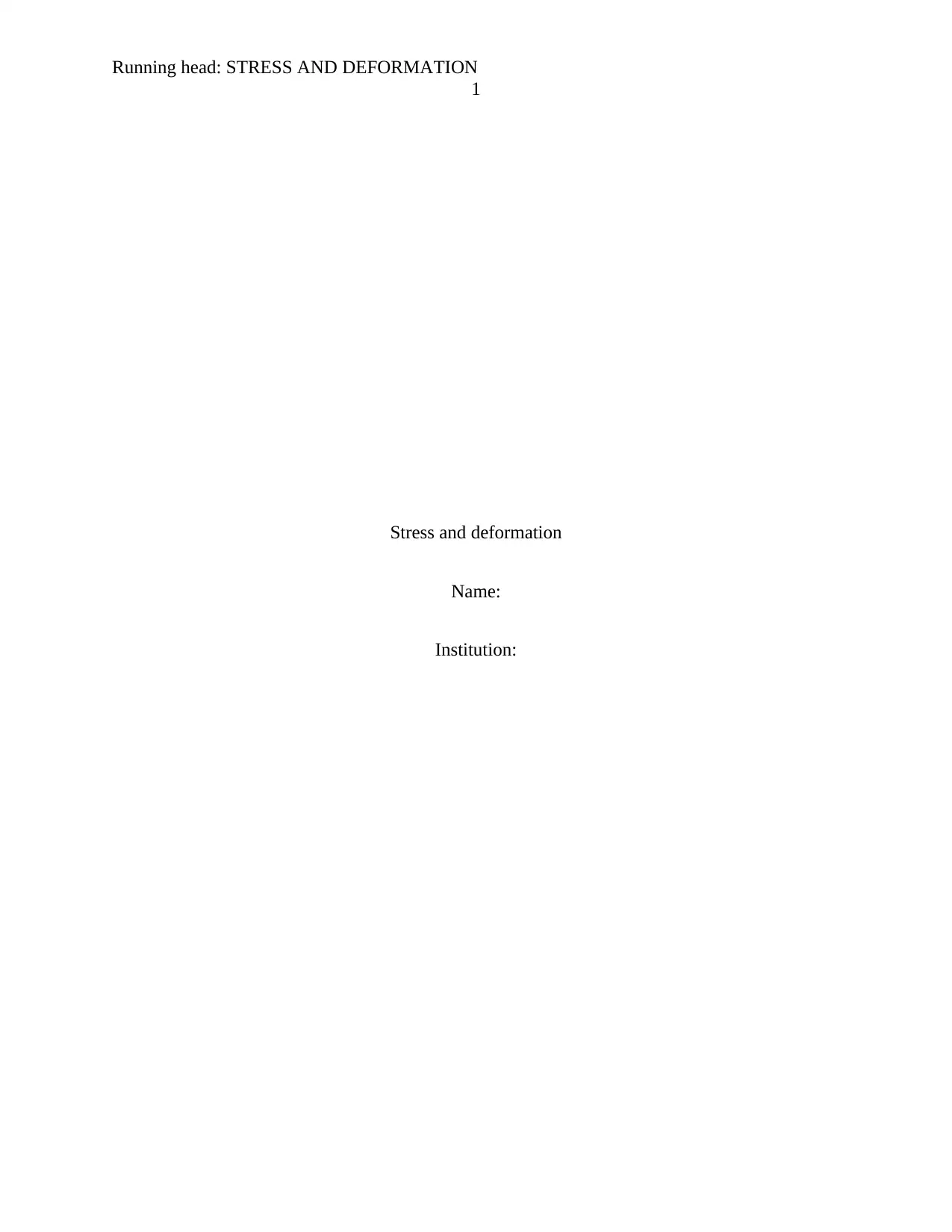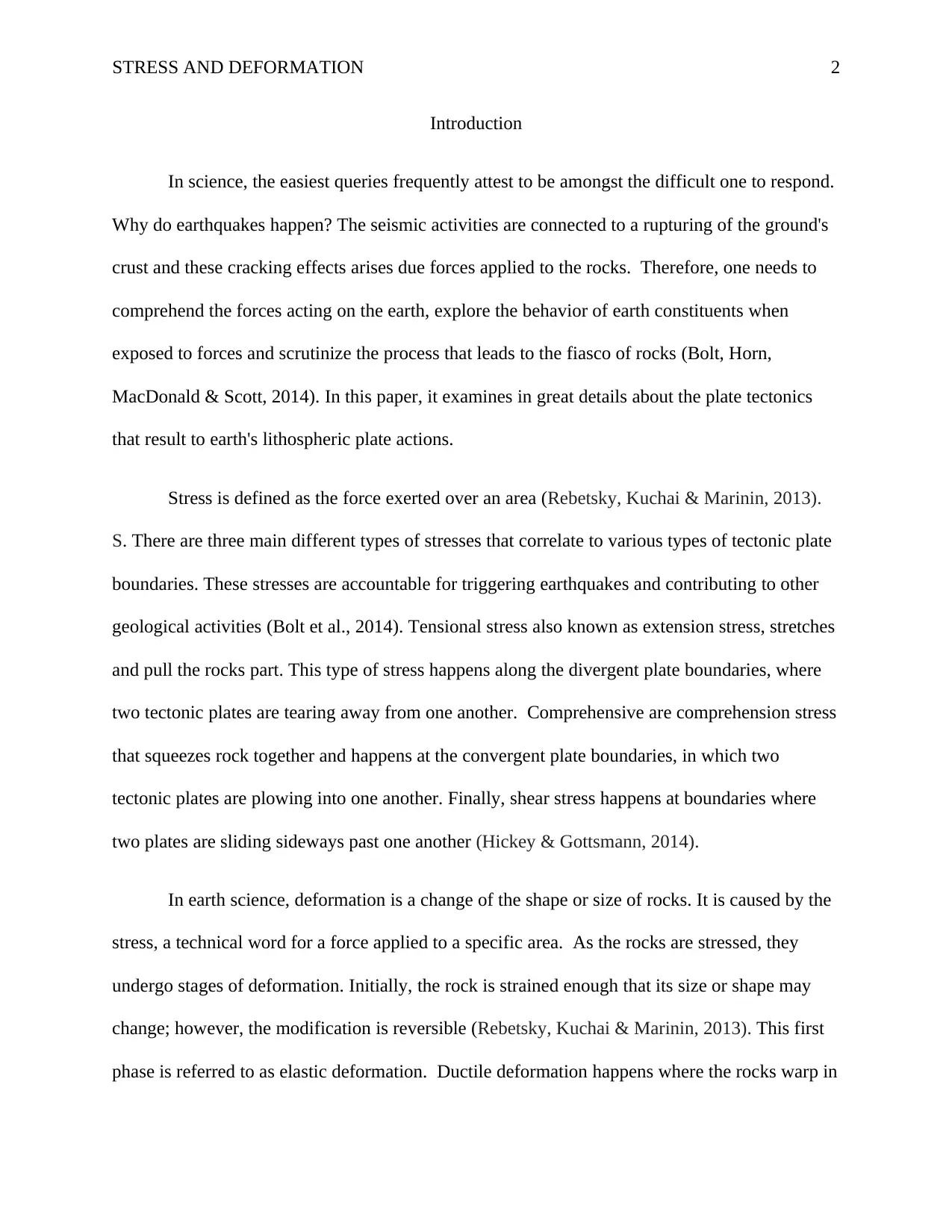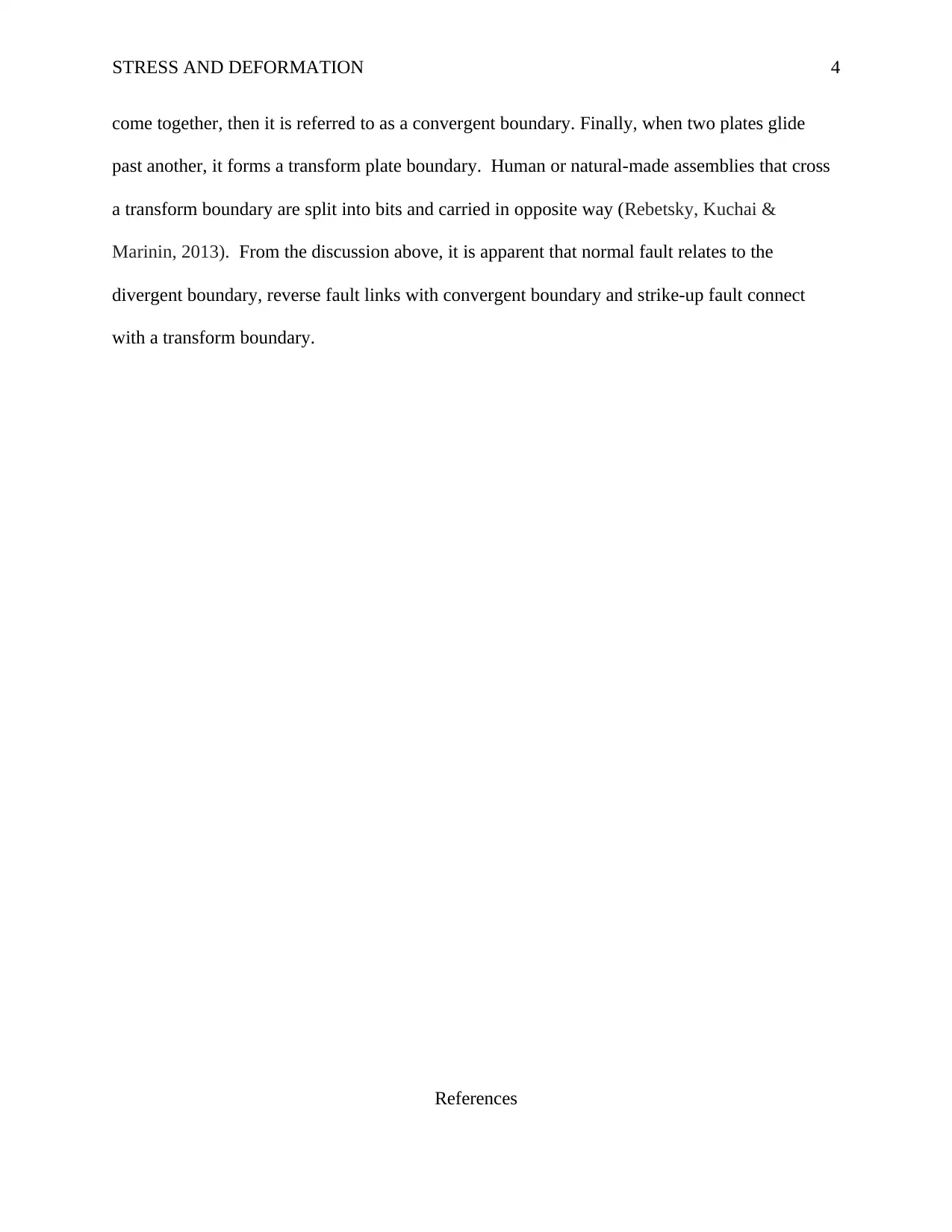Stress and Deformation in Plate Tectonics
VerifiedAdded on 2023/06/03
|5
|1103
|203
AI Summary
This paper examines stress and deformation in plate tectonics and their role in earthquakes and geological activities. It discusses the three main types of stresses and the different types of faults. It also explores tectonics and the different plate boundaries.
Contribute Materials
Your contribution can guide someone’s learning journey. Share your
documents today.

Running head: STRESS AND DEFORMATION
1
Stress and deformation
Name:
Institution:
1
Stress and deformation
Name:
Institution:
Secure Best Marks with AI Grader
Need help grading? Try our AI Grader for instant feedback on your assignments.

STRESS AND DEFORMATION 2
Introduction
In science, the easiest queries frequently attest to be amongst the difficult one to respond.
Why do earthquakes happen? The seismic activities are connected to a rupturing of the ground's
crust and these cracking effects arises due forces applied to the rocks. Therefore, one needs to
comprehend the forces acting on the earth, explore the behavior of earth constituents when
exposed to forces and scrutinize the process that leads to the fiasco of rocks (Bolt, Horn,
MacDonald & Scott, 2014). In this paper, it examines in great details about the plate tectonics
that result to earth's lithospheric plate actions.
Stress is defined as the force exerted over an area (Rebetsky, Kuchai & Marinin, 2013).
S. There are three main different types of stresses that correlate to various types of tectonic plate
boundaries. These stresses are accountable for triggering earthquakes and contributing to other
geological activities (Bolt et al., 2014). Tensional stress also known as extension stress, stretches
and pull the rocks part. This type of stress happens along the divergent plate boundaries, where
two tectonic plates are tearing away from one another. Comprehensive are comprehension stress
that squeezes rock together and happens at the convergent plate boundaries, in which two
tectonic plates are plowing into one another. Finally, shear stress happens at boundaries where
two plates are sliding sideways past one another (Hickey & Gottsmann, 2014).
In earth science, deformation is a change of the shape or size of rocks. It is caused by the
stress, a technical word for a force applied to a specific area. As the rocks are stressed, they
undergo stages of deformation. Initially, the rock is strained enough that its size or shape may
change; however, the modification is reversible (Rebetsky, Kuchai & Marinin, 2013). This first
phase is referred to as elastic deformation. Ductile deformation happens where the rocks warp in
Introduction
In science, the easiest queries frequently attest to be amongst the difficult one to respond.
Why do earthquakes happen? The seismic activities are connected to a rupturing of the ground's
crust and these cracking effects arises due forces applied to the rocks. Therefore, one needs to
comprehend the forces acting on the earth, explore the behavior of earth constituents when
exposed to forces and scrutinize the process that leads to the fiasco of rocks (Bolt, Horn,
MacDonald & Scott, 2014). In this paper, it examines in great details about the plate tectonics
that result to earth's lithospheric plate actions.
Stress is defined as the force exerted over an area (Rebetsky, Kuchai & Marinin, 2013).
S. There are three main different types of stresses that correlate to various types of tectonic plate
boundaries. These stresses are accountable for triggering earthquakes and contributing to other
geological activities (Bolt et al., 2014). Tensional stress also known as extension stress, stretches
and pull the rocks part. This type of stress happens along the divergent plate boundaries, where
two tectonic plates are tearing away from one another. Comprehensive are comprehension stress
that squeezes rock together and happens at the convergent plate boundaries, in which two
tectonic plates are plowing into one another. Finally, shear stress happens at boundaries where
two plates are sliding sideways past one another (Hickey & Gottsmann, 2014).
In earth science, deformation is a change of the shape or size of rocks. It is caused by the
stress, a technical word for a force applied to a specific area. As the rocks are stressed, they
undergo stages of deformation. Initially, the rock is strained enough that its size or shape may
change; however, the modification is reversible (Rebetsky, Kuchai & Marinin, 2013). This first
phase is referred to as elastic deformation. Ductile deformation happens where the rocks warp in

STRESS AND DEFORMATION 3
such as a way that change is reversible. Finally, fracture deformation occur where rocks stresses,
fractures where the change is irreversible and the rock break. Earthquakes happen when energy
kept in elastically stressed rocks is abruptly discharged. This discharge of energy causes strong
earth trembling and propels surfs of elastic vigor denoted as seismic waves (Hu, Liu & Dong,
2014).
Most of the normal earthquakes are caused by abrupt slippage laterally to a fault. Fault
happens when hard rocks fractures and there is movement of one side of the break comparative
to another. Fault can be alienated into diverse types relying on the directive of comparative shift
or slip on the fault. First, normal fault comes from horizontal extensional stress in an inelastic
rocks and where the hanging-wall blocks have progressed down proportional to the footwall
chunk. Second, a thrust fault is a distinctive case of a reverse fault where the dip of the fault is
less than 450 (Hickey & Gottsmann, 2014). This type of fault can have a significant shift, gauging
hundreds of kilometers, and can result in mature strata superimposing the newer strata. Finally,
strike-slip fault happens when the movement on the fault has taken place alongside a horizontal
path. Therefore, tension leads to a normal fault, comprehension leads to reverse or thrust faults
and finally, horizontal shear causes strike-slip faults (Rebetsky, Kuchai & Marinin, 2013).
Tectonics is a large-scale deformation of an outer part of the earth resulting from the
earth forces. The lithosphere, entailing of an uppermost and crust-mantle, is separated into a
huge tectonic plates that change gradually relative to another. Volcanic activity, earthquake and
mountain-building formation happens along plate borders in regions that may a few kilometers to
hundred kilometers broad (Rebetsky, Kuchai & Marinin, 2013). To start with, the divergent
boundary happens when two tectonic plates shift away from another. Along these limits, lava
discharges from elongated geysers and fissures jet superheated water. Secondly, when two plates
such as a way that change is reversible. Finally, fracture deformation occur where rocks stresses,
fractures where the change is irreversible and the rock break. Earthquakes happen when energy
kept in elastically stressed rocks is abruptly discharged. This discharge of energy causes strong
earth trembling and propels surfs of elastic vigor denoted as seismic waves (Hu, Liu & Dong,
2014).
Most of the normal earthquakes are caused by abrupt slippage laterally to a fault. Fault
happens when hard rocks fractures and there is movement of one side of the break comparative
to another. Fault can be alienated into diverse types relying on the directive of comparative shift
or slip on the fault. First, normal fault comes from horizontal extensional stress in an inelastic
rocks and where the hanging-wall blocks have progressed down proportional to the footwall
chunk. Second, a thrust fault is a distinctive case of a reverse fault where the dip of the fault is
less than 450 (Hickey & Gottsmann, 2014). This type of fault can have a significant shift, gauging
hundreds of kilometers, and can result in mature strata superimposing the newer strata. Finally,
strike-slip fault happens when the movement on the fault has taken place alongside a horizontal
path. Therefore, tension leads to a normal fault, comprehension leads to reverse or thrust faults
and finally, horizontal shear causes strike-slip faults (Rebetsky, Kuchai & Marinin, 2013).
Tectonics is a large-scale deformation of an outer part of the earth resulting from the
earth forces. The lithosphere, entailing of an uppermost and crust-mantle, is separated into a
huge tectonic plates that change gradually relative to another. Volcanic activity, earthquake and
mountain-building formation happens along plate borders in regions that may a few kilometers to
hundred kilometers broad (Rebetsky, Kuchai & Marinin, 2013). To start with, the divergent
boundary happens when two tectonic plates shift away from another. Along these limits, lava
discharges from elongated geysers and fissures jet superheated water. Secondly, when two plates

STRESS AND DEFORMATION 4
come together, then it is referred to as a convergent boundary. Finally, when two plates glide
past another, it forms a transform plate boundary. Human or natural-made assemblies that cross
a transform boundary are split into bits and carried in opposite way (Rebetsky, Kuchai &
Marinin, 2013). From the discussion above, it is apparent that normal fault relates to the
divergent boundary, reverse fault links with convergent boundary and strike-up fault connect
with a transform boundary.
References
come together, then it is referred to as a convergent boundary. Finally, when two plates glide
past another, it forms a transform plate boundary. Human or natural-made assemblies that cross
a transform boundary are split into bits and carried in opposite way (Rebetsky, Kuchai &
Marinin, 2013). From the discussion above, it is apparent that normal fault relates to the
divergent boundary, reverse fault links with convergent boundary and strike-up fault connect
with a transform boundary.
References
Secure Best Marks with AI Grader
Need help grading? Try our AI Grader for instant feedback on your assignments.

STRESS AND DEFORMATION 5
Bolt, B. A., Horn, W. L., MacDonald, G. A., & Scott, R. F. (2014). Geological Hazards:
Earthquakes -- Tsunamis -- Volcanoes, Avalanches -- Landslides -- Floods. Berlin:
Springer Berlin.1st ed. [Online]. Retrieved from:https://books.google.com/books?
hl=en&lr=&id=7qffBwAAQBAJ&oi=fnd&pg=PR1&dq=causes+of+earthquakes&ots=F
cGx6mqN94&sig=lSgmpAjIxz8ytXnmXitb0UYri3w, [Accessed on 30 October 2018].
Hickey, J., & Gottsmann, J. (2014). Benchmarking and developing numerical Finite Element
models of volcanic deformation. Journal of Volcanology and Geothermal Research, 280,
126-130. [Online]. Retrieved from:
https://www.sciencedirect.com/science/article/pii/S037702731400153X, [Accessed on 30
October 2018].
Hu, Y. X., Liu, S. C., & Dong, W. (2014). Earthquake engineering. CRC Press.1st ed. [Online].
Retrieved from: https://www.taylorfrancis.com/books/9781482271645, [Accessed on 30
October 2018].
Rebetsky, Y. L., Kuchai, O. A., & Marinin, A. V. (2013). Stress state and deformation of the
Earth’s crust in the Altai–Sayan mountain region. Russian Geology and
Geophysics, 54(2), 206-222. [Online]. Retrieved from:
https://www.researchgate.net/profile/Yu_Rebetsky/publication/257480743_Stress_state_
and_deformation_of_the_Earth%27s_crust_in_the_Altai-Sayan_mountain_region/links/
5a31f9a50f7e9b2a28d5ceed/Stress-state-and-deformation-of-the-Earths-crust-in-the-
Altai-Sayan-mountain-region.pdf, [Accessed on 30 October 2018].
Bolt, B. A., Horn, W. L., MacDonald, G. A., & Scott, R. F. (2014). Geological Hazards:
Earthquakes -- Tsunamis -- Volcanoes, Avalanches -- Landslides -- Floods. Berlin:
Springer Berlin.1st ed. [Online]. Retrieved from:https://books.google.com/books?
hl=en&lr=&id=7qffBwAAQBAJ&oi=fnd&pg=PR1&dq=causes+of+earthquakes&ots=F
cGx6mqN94&sig=lSgmpAjIxz8ytXnmXitb0UYri3w, [Accessed on 30 October 2018].
Hickey, J., & Gottsmann, J. (2014). Benchmarking and developing numerical Finite Element
models of volcanic deformation. Journal of Volcanology and Geothermal Research, 280,
126-130. [Online]. Retrieved from:
https://www.sciencedirect.com/science/article/pii/S037702731400153X, [Accessed on 30
October 2018].
Hu, Y. X., Liu, S. C., & Dong, W. (2014). Earthquake engineering. CRC Press.1st ed. [Online].
Retrieved from: https://www.taylorfrancis.com/books/9781482271645, [Accessed on 30
October 2018].
Rebetsky, Y. L., Kuchai, O. A., & Marinin, A. V. (2013). Stress state and deformation of the
Earth’s crust in the Altai–Sayan mountain region. Russian Geology and
Geophysics, 54(2), 206-222. [Online]. Retrieved from:
https://www.researchgate.net/profile/Yu_Rebetsky/publication/257480743_Stress_state_
and_deformation_of_the_Earth%27s_crust_in_the_Altai-Sayan_mountain_region/links/
5a31f9a50f7e9b2a28d5ceed/Stress-state-and-deformation-of-the-Earths-crust-in-the-
Altai-Sayan-mountain-region.pdf, [Accessed on 30 October 2018].
1 out of 5
Your All-in-One AI-Powered Toolkit for Academic Success.
+13062052269
info@desklib.com
Available 24*7 on WhatsApp / Email
![[object Object]](/_next/static/media/star-bottom.7253800d.svg)
Unlock your academic potential
© 2024 | Zucol Services PVT LTD | All rights reserved.



